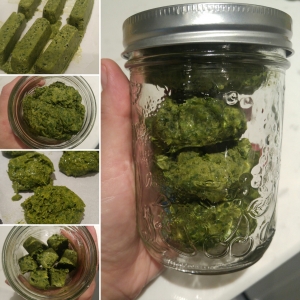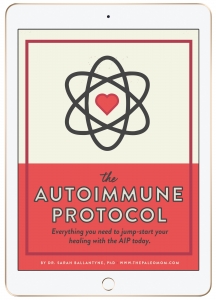This post contains affiliate links. Click here to see what that means.
When you’re on the AIP you’re likely doing a lot more cooking than usual. You’re probably batch cooking, and meal prepping for the freezer, but what’s the best way to store all of this delicious food? Does it matter what we use? Need the 4-1-1 on food storage basics? You’ve come to the right place!
Since we’re trying to live a toxin-free life on the AIP to give our bodies the fighting chance they need to heal, it’s a good idea to consider what you’re using for food storage. There are a lot of opinions out there about plastics, BPA-Free options, silicone and more (read more about why we should avoid plastics here). For me, I kick it old school as much as possible – zero waste, sustainable living, lovable, reusable glass!
Since I get asked a LOT about food storage, and especially about how to safely use glass jars in the freezer, that is the main focus of this article – I hope it helps!
Planning Tips:
The first pointer that I’m going to offer is a bit of a warning – batch cooking can be exhausting – especially in the beginning when you’re really not feeling well, so try to pick a day when you’re feeling up to it. Better yet have a friend or family member jump in to help you tag-team it. And it doesn’t have to be all about you – you can work together to create a bunch of delicious options so that they go home with food to stock their fridge and freezer too. Many hands make light work.
My second pointer – don’t go overboard if you don’t have the space to store it all! I’ve done this before when I was feeling super ambitious, I cooked way more than I needed for a week or two and found my fridge stuffed to the brim and I didn’t really want to store much of what I’d made in the freezer because it wasn’t all that freezer friendly. So, evaluate the space you have and choose recipes to prep according to where and how you plan to store it.
The third pointer is to have your containers ready! There’s nothing worse than batch cooking and then scrambling to find suitable food storage to put it all in. Plan ahead for this. If you’ve never batch cooked before you might need to consider investing in some quality meal containers. Glass if obviously the gold standard, safest method for storing food, and there are some awesome options on the market these days that make prepping a breeze (check out some of my faves in my shopping resources – click here). If you can’t afford to buy new containers, save up any glass jars you have from store-bought items or check a local thrift store, I know our family donates a lot of glass mason jars when we simply get overwhelmed by the amount we have on hand. If you’re lucky enough to score some of those, your investment will be minimal in that you’ll just need to buy some new lids.
Practical Tips – Glass Jars #1:
Super … You’re all set!
Now, you may have heard horror stories of using glass jars in the freezer, am I right? I had heard stories too, but was always fortunate enough not to have any issues … leave enough space at the top of the jar for expansion and you’re good to go! Well …. not always! Even if you manage to freeze them without breaking, they can still break during thawing.
Eventually, my luck ran out. When I started freezing bone broth I ran into troubles and there were tears shed over bone broth lost. I attribute some of my issues to using inappropriate jars and the fact that my upright freezer has coils in the shelves … so I’ve gotten a little smarter about all this.
For me, I’m usually just freezing liquids in jars – sauces, soup, broth, stew and maybe shepherd’s pie. Freezing liquids can be tricky, so here are a few practical tips:
- The Jar – the wider the jar the better. Try to avoid tall skinny jars, and if possible use wide-mouth jars without “shoulders” (that just means that the jar is straight from bottom to top and it does not get smaller as it approaches the opening).
- Filling The Jar – only fill it 3/4 of the way full or less to ensure you allow plenty of room for expansion as the contents freeze and expand.
- Position – always freeze jars standing up.
- Freezer Considerations – if you have an upright freezer with freezer coils in the shelves, consider placing your jars in a shallow plastic container until they have frozen successfully. I started doing this just in case they broke so there would be something to catch the liquid, but in actual fact I think the barrier between the glass and the coils made a difference.
- Temperature – ALWAYS ensure your liquid is completely cooled before attempting to freeze. Some say allowing them to come to room temperature is sufficient, but I usually err on the side of caution and refrigerate them first until completely cold.
- Thawing – NEVER try to thaw quickly! SLOW and STEADY wins this race! Ideally you should remove your frozen jar to the refrigerator for a few hours – NEVER place jars straight from the freezer into hot water – breakage is almost guaranteed! Plan ahead and thaw slowly in the fridge and then the counter top – that’s your best bet.
Practical Tips – Glass Jars #2:
Another way to use glass jars for freezer storage is to first pre-freeze your liquids in ice cube trays or silicone trays that hold larger amounts. Once your liquids are frozen you pop them out of the trays and into glass jars and you should have no problem putting your jars straight in the freezer.
This method is great for freezing things like pesto, sauces and bone broth since it allows you to easily portion out what you need instead of having to thaw a whole jar of food. Think about the number of times you need a cup of broth or a few tablespoons of sauce! Dispensing a few cubes from a jar also allows you to thaw them more quickly in a safe container or by popping them right into the dish you’re cooking.
Glass Storage Containers:
There are plenty of larger, shallow options for storing all kinds of food available these days. There are even containers that have sections so you can portion out a complete meal but keep items separate. Containers like this are great for meal prepping and are typically thicker and more sturdy than a glass jar. While you should still proceed with caution when freezing and thawing these containers, you’ll likely have fewer concerns since you’ll probably not be storing liquids but rather solid food and there will be lots of air gaps for expansion. Follow the directions that come with your containers and you should be just fine!
What About Freezer Burn?
Freezer burn is caused by the moisture loss in the freezer. It can lead to ice crystals, shriveled product, tough, leathery or discolored meats.
You can minimize freezer burn by making sure your food is cold before you set out, so let it cook and then proceed. You may even want to store it in the fridge first and then move on to freezing.
The key is oxidization or exposure to air – you want to minimize that by properly packaging your food. If you plan to buy a lot of meat in bulk, you have a garden and plan on preserving your harvest or you like to buy in bulk when things are on sale, you might want to invest in a vacuum sealing system (you can find some great options in my Amazon Storefronts under small appliances – the brand that I recommend uses BPA free plastics click here to find the link for your area).
If you just need a few pointers to do your best without a system, read on…
- For meat, poultry and seafood you can wrap it in freezer paper (or plastic wrap – but I don’t like plastic for reasons mentioned above) and then in foil and then pop it in a freezer bag and remove as much air as possible.
- When packaging fruit and vegetables use small containers to minimize empty space when freezing leftovers. You can also use the same wrapping technique as for meat in some cases.
- HOT TIP: Use a straw to suck the air out of your freezer bag once it’s almost completely zipped up!
- Keep your freezer temperature as consistent as possible – avoid opening and closing it unnecessarily.
- Use your food faster. It’s best to use your frozen foods within 2-4 months, so be sure to add dates to your frozen packages and rotate your inventory.
Too late? Your food’s already got freezer burn? Bummer! Don’t worry though, your food is still safe to eat – the texture may not be the same and it just may not taste as good as it once did, so plan to use it in more forgiving dishes like soups, stews, sauces or smoothies instead.
How Long Is My Food Safe & How Should I Store It?
Since you know I’m not one for re-writing well presented material, I’m simply going to direct you to a couple of great articles:
Autoimmune Wellness – AIP Food Storage Basics – These post will help you figure out how long food should stay fresh and safe and where you should store it.
Healthline – Food Storage – This post covers freezer burn, safe meat storage guidelines (fridge and freezer), how to know if your chicken has gone bad, fruit and veggie storage, canned food storage guidelines and more! (Once you’re there – just keep scrolling)
And because, on the AIP especially we don’t want to waste any precious ingredients (I know a lot of us are on a budget) you can read my post about managing the AIP on a Budget.



 Where to Begin?
Where to Begin?